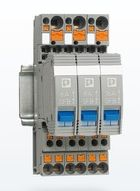
Always the right choice – whether high starting currents, long cable paths or remote signaling of the operating state.

Our thermomagnetic device circuit breakers are used in information, communication, and process technology. Thanks to the various tripping characteristics, the circuit breakers can be used in a wide range of applications. Integrated remote signaling enables you to permanently monitor the operating state of your system.
Thermomagnetic circuit breakers are triggered both thermally and magnetically. The two systems, bimetal and solenoid, operate independently of one another.
This means that in the event of a short circuit, thermomagnetic circuit breakers trip more quickly than thermal circuit breakers.
Therefore, in the event of a short circuit the trigger mechanism is actuated within 3 - 5 ms.
Use device circuit breakers with optimized SFB (selective fuse breaking) characteristic curve to implement longer cable paths in your system. In conjunction with QUINT POWER power supply units from Phoenix Contact, you can achieve maximum protection for your cables and devices. The circuit breakers can be switched on again at any time.
Our thermomagnetic circuit breakers are available in one-piece and plug-in versions. Choose between screw connection and push-in connection technology.
Thermomagnetic device circuit breakers are used primarily in information and communication technology as well as process control. Thanks to the various tripping characteristics and precise nominal current levels, the circuit breakers can be used in a wide range of applications.
For example, they are ideal for protecting programmable logic controllers, valves, motors, and frequency inverters.